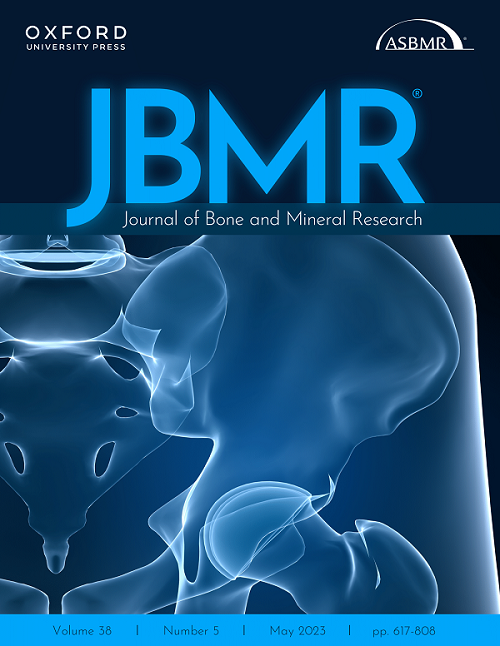Al-Gazali Skeletal Dysplasia Constitutes the Lethal End of ADAMTSL2-Related Disorders
IF 5.1
1区 医学
Q1 ENDOCRINOLOGY & METABOLISM
Dominyka Batkovskyte, Fiona McKenzie, Fulya Taylan, Pelin Ozlem Simsek-Kiper, Sarah M Nikkel, Hirofumi Ohashi, Roger E Stevenson, Thuong Ha, Denise P Cavalcanti, Hiroyuki Miyahara, Steven A Skinner, Miguel A Aguirre, Zühal Ak??ren, Gulen Eda Utine, Tillie Chiu, Kenji Shimizu, Anna Hammarsj?, Koray Boduroglu, Hannah W Moore, Raymond J Louie, Peer Arts, Allie N Merrihew, Milena Babic, Matilda R Jackson, Nikos Papadogiannakis, Anna Lindstrand, Ann Nordgren, Christopher P Barnett, Hamish S Scott, Andrei S Chagin, Gen Nishimura, Giedre Grigelioniene
下载PDF
{"title":"Al-Gazali Skeletal Dysplasia Constitutes the Lethal End of ADAMTSL2-Related Disorders","authors":"Dominyka Batkovskyte, Fiona McKenzie, Fulya Taylan, Pelin Ozlem Simsek-Kiper, Sarah M Nikkel, Hirofumi Ohashi, Roger E Stevenson, Thuong Ha, Denise P Cavalcanti, Hiroyuki Miyahara, Steven A Skinner, Miguel A Aguirre, Zühal Ak??ren, Gulen Eda Utine, Tillie Chiu, Kenji Shimizu, Anna Hammarsj?, Koray Boduroglu, Hannah W Moore, Raymond J Louie, Peer Arts, Allie N Merrihew, Milena Babic, Matilda R Jackson, Nikos Papadogiannakis, Anna Lindstrand, Ann Nordgren, Christopher P Barnett, Hamish S Scott, Andrei S Chagin, Gen Nishimura, Giedre Grigelioniene","doi":"10.1002/jbmr.4799","DOIUrl":null,"url":null,"abstract":"<p>Lethal short-limb skeletal dysplasia Al-Gazali type (OMIM %601356), also called dysplastic cortical hyperostosis, Al-Gazali type, is an ultra-rare disorder previously reported in only three unrelated individuals. The genetic etiology for Al-Gazali skeletal dysplasia has up until now been unknown. Through international collaborative efforts involving seven clinical centers worldwide, a cohort of nine patients with clinical and radiographic features consistent with short-limb skeletal dysplasia Al-Gazali type was collected. The affected individuals presented with moderate intrauterine growth restriction, relative macrocephaly, hypertrichosis, large anterior fontanelle, short neck, short and stiff limbs with small hands and feet, severe brachydactyly, and generalized bone sclerosis with mild platyspondyly. Biallelic disease-causing variants in <i>ADAMTSL2</i> were detected using massively parallel sequencing (MPS) and Sanger sequencing techniques. Six individuals were compound heterozygous and one individual was homozygous for pathogenic variants in <i>ADAMTSL2</i>. In one of the families, pathogenic variants were detected in parental samples only. Overall, this study sheds light on the genetic cause of Al-Gazali skeletal dysplasia and identifies it as a semi-lethal part of the spectrum of <i>ADAMTSL2</i>-related disorders. Furthermore, we highlight the importance of meticulous analysis of the pseudogene region of <i>ADAMTSL2</i> where disease-causing variants might be located. © 2023 The Authors. <i>Journal of Bone and Mineral Research</i> published by Wiley Periodicals LLC on behalf of American Society for Bone and Mineral Research (ASBMR).</p>","PeriodicalId":185,"journal":{"name":"Journal of Bone and Mineral Research","volume":"38 5","pages":"692-706"},"PeriodicalIF":5.1000,"publicationDate":"2023-03-10","publicationTypes":"Journal Article","fieldsOfStudy":null,"isOpenAccess":false,"openAccessPdf":"https://onlinelibrary.wiley.com/doi/epdf/10.1002/jbmr.4799","citationCount":"1","resultStr":null,"platform":"Semanticscholar","paperid":null,"PeriodicalName":"Journal of Bone and Mineral Research","FirstCategoryId":"3","ListUrlMain":"https://onlinelibrary.wiley.com/doi/10.1002/jbmr.4799","RegionNum":1,"RegionCategory":"医学","ArticlePicture":[],"TitleCN":null,"AbstractTextCN":null,"PMCID":null,"EPubDate":"","PubModel":"","JCR":"Q1","JCRName":"ENDOCRINOLOGY & METABOLISM","Score":null,"Total":0}
引用次数: 1
引用
批量引用
Abstract
Lethal short-limb skeletal dysplasia Al-Gazali type (OMIM %601356), also called dysplastic cortical hyperostosis, Al-Gazali type, is an ultra-rare disorder previously reported in only three unrelated individuals. The genetic etiology for Al-Gazali skeletal dysplasia has up until now been unknown. Through international collaborative efforts involving seven clinical centers worldwide, a cohort of nine patients with clinical and radiographic features consistent with short-limb skeletal dysplasia Al-Gazali type was collected. The affected individuals presented with moderate intrauterine growth restriction, relative macrocephaly, hypertrichosis, large anterior fontanelle, short neck, short and stiff limbs with small hands and feet, severe brachydactyly, and generalized bone sclerosis with mild platyspondyly. Biallelic disease-causing variants in ADAMTSL2 were detected using massively parallel sequencing (MPS) and Sanger sequencing techniques. Six individuals were compound heterozygous and one individual was homozygous for pathogenic variants in ADAMTSL2 . In one of the families, pathogenic variants were detected in parental samples only. Overall, this study sheds light on the genetic cause of Al-Gazali skeletal dysplasia and identifies it as a semi-lethal part of the spectrum of ADAMTSL2 -related disorders. Furthermore, we highlight the importance of meticulous analysis of the pseudogene region of ADAMTSL2 where disease-causing variants might be located. © 2023 The Authors. Journal of Bone and Mineral Research published by Wiley Periodicals LLC on behalf of American Society for Bone and Mineral Research (ASBMR).
Al-Gazali骨骼发育不良是adamtsl2相关疾病的致命终点
致死性短肢骨骼发育不良Al-Gazali型(OMIM %601356),也被称为发育不良皮质肥厚症,Al-Gazali型,是一种极其罕见的疾病,以前只报道过在三个不相关的个体中发生。到目前为止,Al-Gazali骨骼发育不良的遗传病因尚不清楚。通过全球7个临床中心的国际合作,收集了9例具有与Al-Gazali型短肢骨骼发育不良相一致的临床和影像学特征的患者。患者表现为中度宫内生长受限、相对大头畸形、多毛、前囟门大、颈部短、四肢短而僵硬、手脚小、严重的短指畸形、全身性骨硬化伴轻度平椎。采用大规模平行测序(MPS)和Sanger测序技术检测ADAMTSL2的双等位致病变异。ADAMTSL2致病性变异有6个个体为复合杂合,1个个体为纯合。在其中一个家族中,仅在亲本样本中检测到致病性变异。总的来说,这项研究揭示了Al-Gazali骨骼发育不良的遗传原因,并将其确定为adamtsl2相关疾病谱系中的半致死部分。此外,我们强调了细致分析ADAMTSL2致病变异可能所在的假基因区域的重要性。©2023作者。由Wiley期刊有限责任公司代表美国骨与矿物研究协会(ASBMR)出版的骨与矿物研究杂志。
本文章由计算机程序翻译,如有差异,请以英文原文为准。
来源期刊
期刊介绍:
The Journal of Bone and Mineral Research (JBMR) publishes highly impactful original manuscripts, reviews, and special articles on basic, translational and clinical investigations relevant to the musculoskeletal system and mineral metabolism. Specifically, the journal is interested in original research on the biology and physiology of skeletal tissues, interdisciplinary research spanning the musculoskeletal and other systems, including but not limited to immunology, hematology, energy metabolism, cancer biology, and neurology, and systems biology topics using large scale “-omics” approaches. The journal welcomes clinical research on the pathophysiology, treatment and prevention of osteoporosis and fractures, as well as sarcopenia, disorders of bone and mineral metabolism, and rare or genetically determined bone diseases.

 求助内容:
求助内容: 应助结果提醒方式:
应助结果提醒方式:


